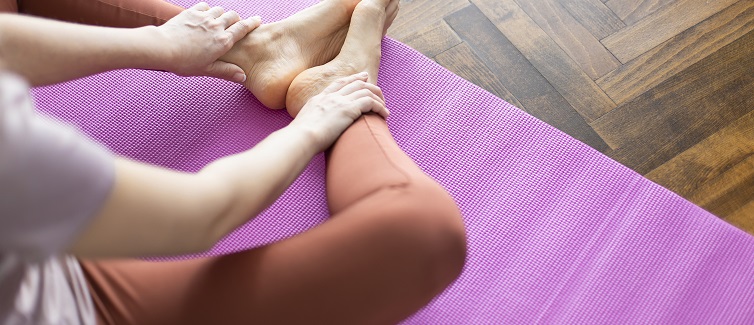Your hip flexors, a group of muscles at the front of your hips, help you flex your leg. They come in handy for everything from walking up a set of stairs to kicking a ball to bending forward.
The hip flexor muscles also affect your lumbar spine. If your hip flexors are too tight, they may contribute to low back pain.
Never Miss a Beat!
Subscribe to Our HealthBeat Newsletter!
Thank you for subscribing!
You can now select the specific newsletters you'd like to receive.
You are already subscribed.
Subscribe to more newsletters in our email preference center.
Sorry, an error occurred. Please try again later.
Get Healthy Tips Sent to Your Phone!
What Hurts Hip Flexors
Sedentary behavior — also known as sitting too much — may result in shortened hip flexor muscles, decreasing your flexibility.
Injuries can also damage your hip flexors. Athletes like football kickers commonly deal with hip flexor strains. People who play ice hockey or soccer and avid runners are prone to hip flexor injuries.
When your hip flexors are tight or overworked, it can lead to:
- Muscle fatigue.
- Difficulty balancing.
- Reduced sports performance.
- Trouble recruiting the correct muscles for specific movements.
- Altered movement patterns that may be associated with other lower extremity injuries.
Can Stretching Help Hip Flexor Tightness?
There’s been a lot of debate about stretching in recent years. Sometimes stretching can help performance, but other times it can inhibit it. In the case of hip flexors, most recent research shows that stretching can decrease tightness and extend the hip’s range of motion.
Stretching the hip flexors for no longer than two minutes may positively affect balance and jumping performance. Stretches are beneficial for activities like dancing and gymnastics, which require considerable hip extension. Hip flexor stretching may also help protect against future injuries.
5 Stretches for Tight Hip Flexors
Want to help your hip flexors move better? Try the 5 stretches detailed below.
Self-myofascial release of the tensor fascia latae
To target your tensor fascia latae, a muscle on the outside of the thigh, lie on your side. Position a foam roller just below your hip bone and slowly roll down a few inches. When you find a tight spot, hold for 30 to 120 seconds. Repeat on the opposite side.
Self-myofascial release of the rectus femoris
Another good muscle to target for myofascial release is the rectus femoris, located in the middle of your quadriceps.
Lying face down and propped up on your elbows, place a foam roller just below your hips. Slowly roll until the foam roller is just above the knees. When you find a tight spot, hold for 30 to 120 seconds.
You can also do this with a single leg, which puts extra pressure on the tight muscle.
Kneeling hip flexor stretch
To do the kneeling hip flexor stretch, start by kneeling on the floor. Next, move one foot in front of you, with your forward knee directly over your foot at a 90-degree angle. Keep your other knee on the floor. You may want a mat under your knee for comfort.
Slowly push your hips forward — keeping them square — until you feel the stretch in the upper thigh of your rear leg. Hold for 15 to 30 seconds, then repeat on the other side.
Butterfly stretch
Sitting on the floor, press the bottoms of your feet together in front of you. Your legs should create a diamond shape with your knees out to the side. Hold your feet in your hands and lean forward with your back straight.
Gently press your knees down toward the floor with your elbows for an extra stretch. Bringing your feet closer to your body will also intensify the stretch. Hold for 30 seconds.
Pigeon Pose
To get into a pigeon pose, start on your hands and knees. Bring your right leg forward and bend it so that your right knee is near your right hand. The sole of your right foot should be near your left hand.
Extend your left leg straight behind you. Keep your hips square to the ground.
If you can, begin to fold your torso over your bent right leg. You’ll feel the hip flexor in the left leg stretch. Hold for up to two minutes, then switch sides.
To learn more or schedule an appointment with UPMC Sports Medicine, visit our website or call 1-855-937-7678.
Sources
Andreas Konrad et al. "The Influence of Stretching the Hip Flexor Muscles on Performance Parameters. A Systematic Review with Meta-Analysis." International Journal of Environmental Research and Public Health. Link
Andrew Mills. "Addressing Overactive Hip Flexors with Corrective Exercise." National Academy of Sports Medicine. Link
"How to Identify and Correct Tight Hip Flexors." International Sports Science Association. Link
Hussain I. Younis Aslan et al. "Acute Effects of Two Hip Flexor Stretching Techniques on Knee Joint Position Sense and Balance. International Journal of Sports Physical Therapy. Link
Timothy G. Eckard et al. "Epidemiology of Hip Flexor and Hip Adductor Strains in National Collegiate Athletic Association Athletes, 2009/2010-2014/2015." The American Journal of Sports Medicine. Link
About Sports Medicine
An athletic lifestyle carries the potential for injury. Whether you’re an elite athlete or a weekend warrior, UPMC Sports Medicine can help. If you are looking to prevent, treat, or rehabilitate a sports injury, our multidisciplinary team of experts can help you get back into the game. If you are seeking to improve your athletic performance, we can work with you to meet your goals. We serve athletes and active people of all ages and experience levels. Our goal is to help you keep doing what you love. Visit our website to find a specialist near you.
